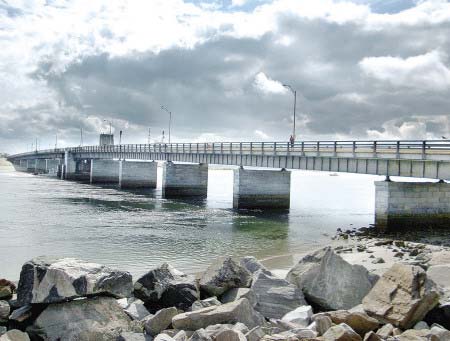By By Patrick Cronin
Hampton Union, Tuesday, September 19, 2006
[The following article is courtesy of the Hampton Union and Seacoast Online.]

[Hampton Union Photo by Jamie Cohen, not in original article]
HAMPTON —- There is another roadblock in the town’s quest to get a new Route 1A Hampton Harbor Bridge.
Steven Boyington, of the state Department of Transportation, said if the town wants to see a new bridge in the future it will have to work out an arrangement with the state’s Historical Commission.
Boyington explained the DOT signed an agreement with the state’s Historical Commission that it would maintain the existing bridge because it’s one of only two bridges in the state that has a lift span.
The agreement was signed after the DOT removed a lift span from another bridge without the Historical Commission’s consent.
Hampton Beach Commission Chairman Fred Rice said he doesn’t believe the town should have to suffer from an agreement that was signed without the town’s knowledge.
“I don’t know if the state has full authority to obligate the town of Hampton like this,” Rice said. “I plan to investigate it and see what the agreement entails. There may be some kind of mechanism that would allows us to just keep the lift bridge as an exhibit.”
Rice said agreement or not, it shouldn’t get in the way of the town’s movement to secure funding for a new bridge.
The Hampton Beach Commission has been pushing for a new four-lane bridge to ease traffic congestion and to provide better local evacuation routes in the event of a disaster.
DOT, however, is only offering to rehab the existing bridge.
Boyington said the agreement the DOT signed with the Historical Commission is not the main reason why a new four-lane bridge without a lift was not one of the options they presented to public last week on rehabbing the bridge.
David Scott, of DOT’s bureau of bridge design, said the state doesn’t have the estimated $30 million for a new bridge
The state unveiled two options for rehabbing the existing bridge, a minimal rehab or a full rehab.
Rice said he is pushing for the minimal rehab because it will give the town more time to try to secure funding for a new four-lane bridge without a lift.
“If they fully rehabilitate that the bridge, we will not see a new bridge in our lifetime,” Rice said.
Boyington said the minimal rehab consists of work that can’t wait any longer and will last eight to 10 years before the rest of the repairs have to be done on the bridge.
A minimal rehab could be done in one season while a full rehab could take up to three years.
Boyington said the work would be done during the winter months, either closing the bridge at night or using alternating one-way traffic.
Selectmen will make the final decision on which option they would like to see done, Boyington said.